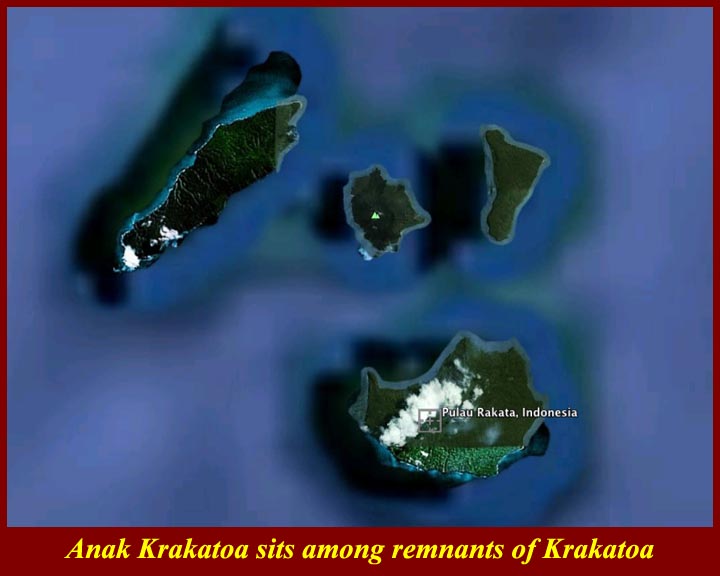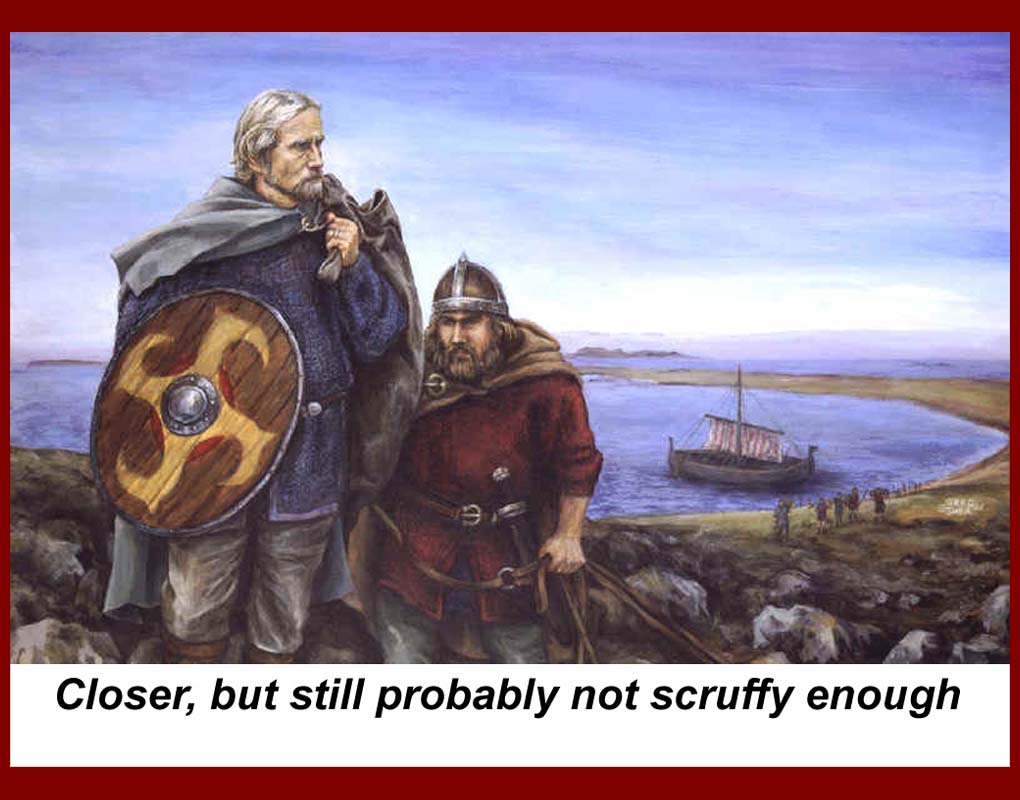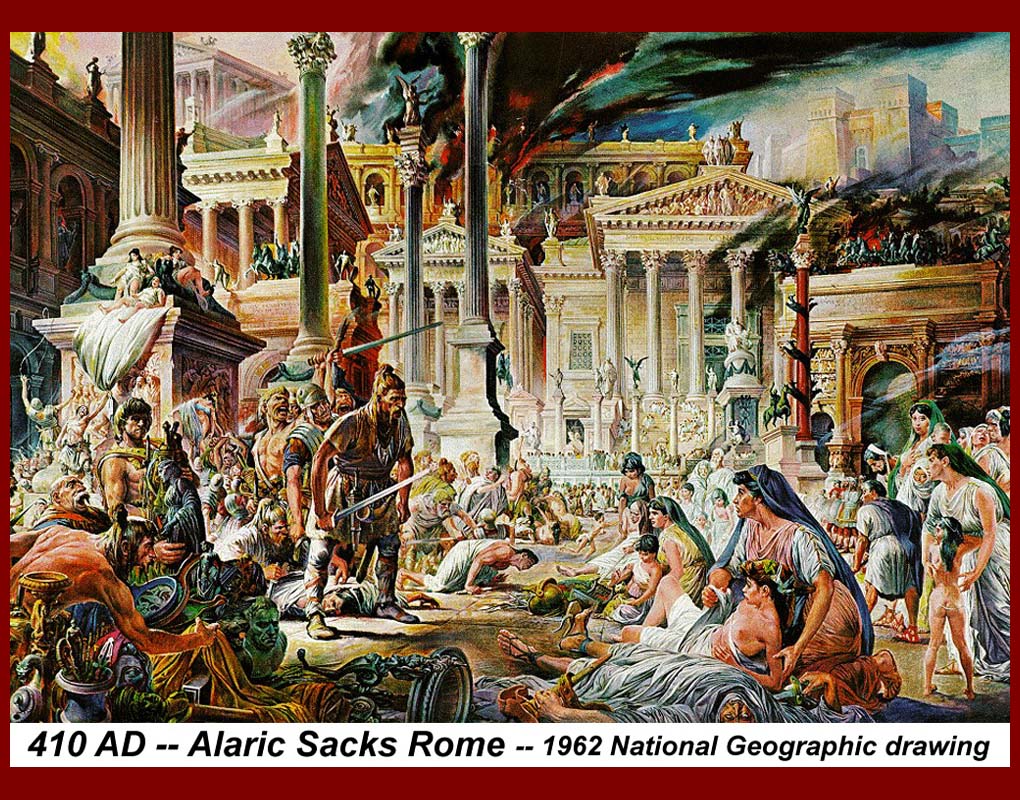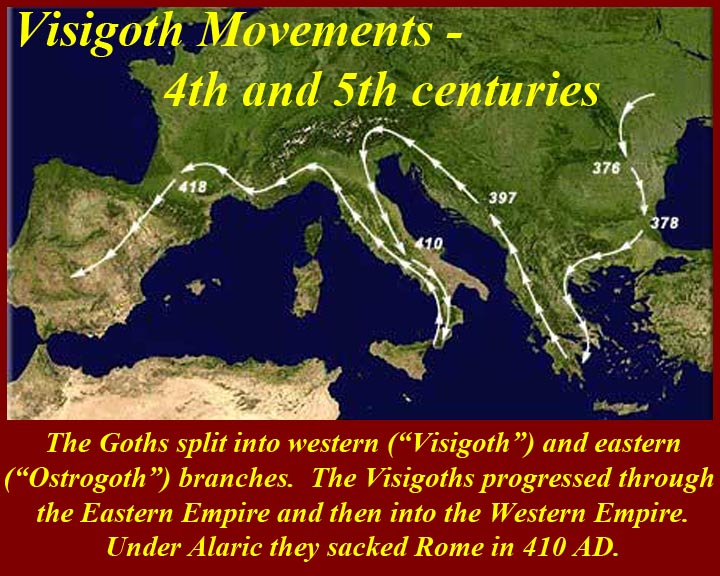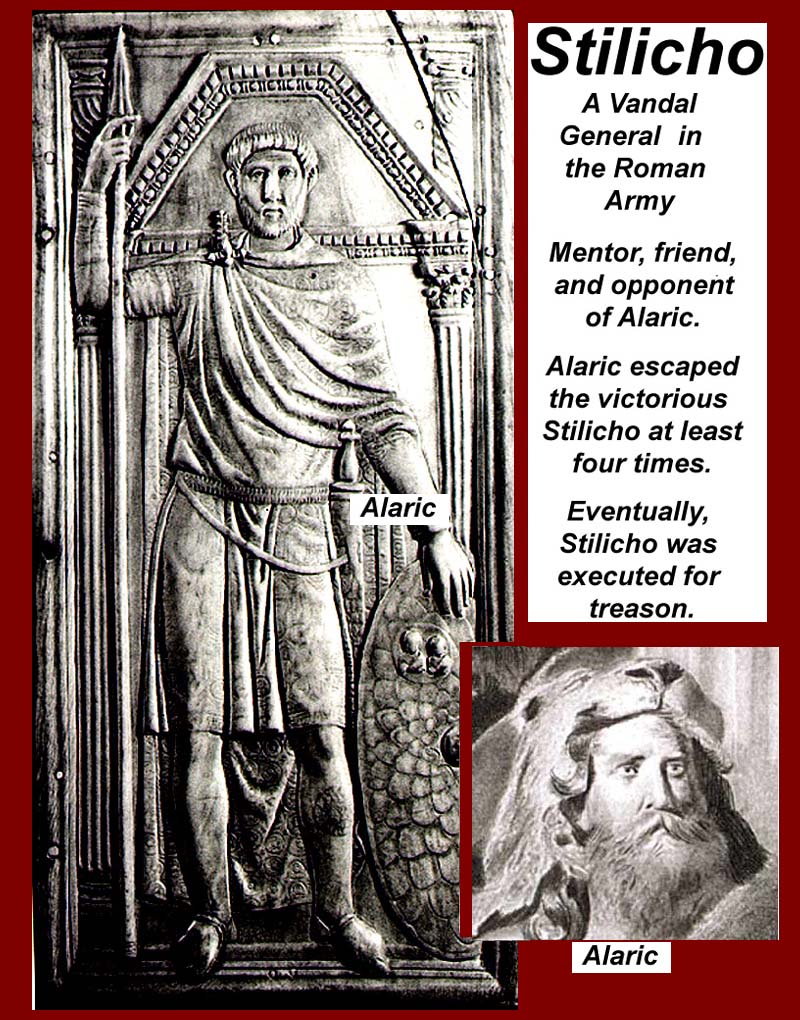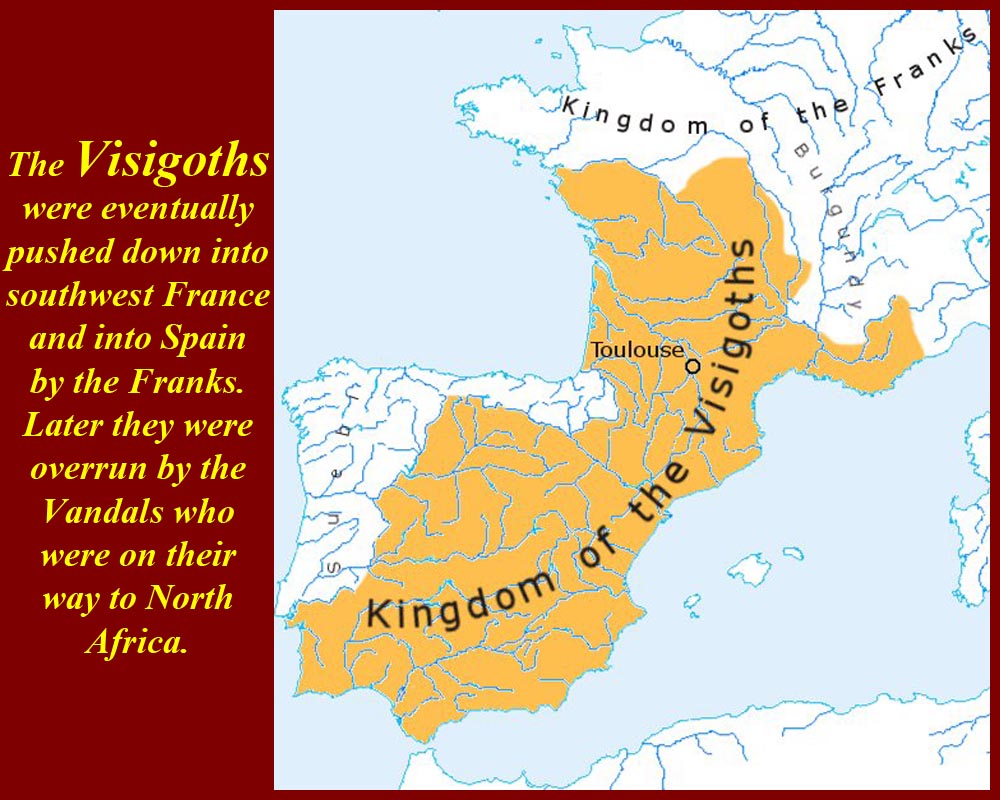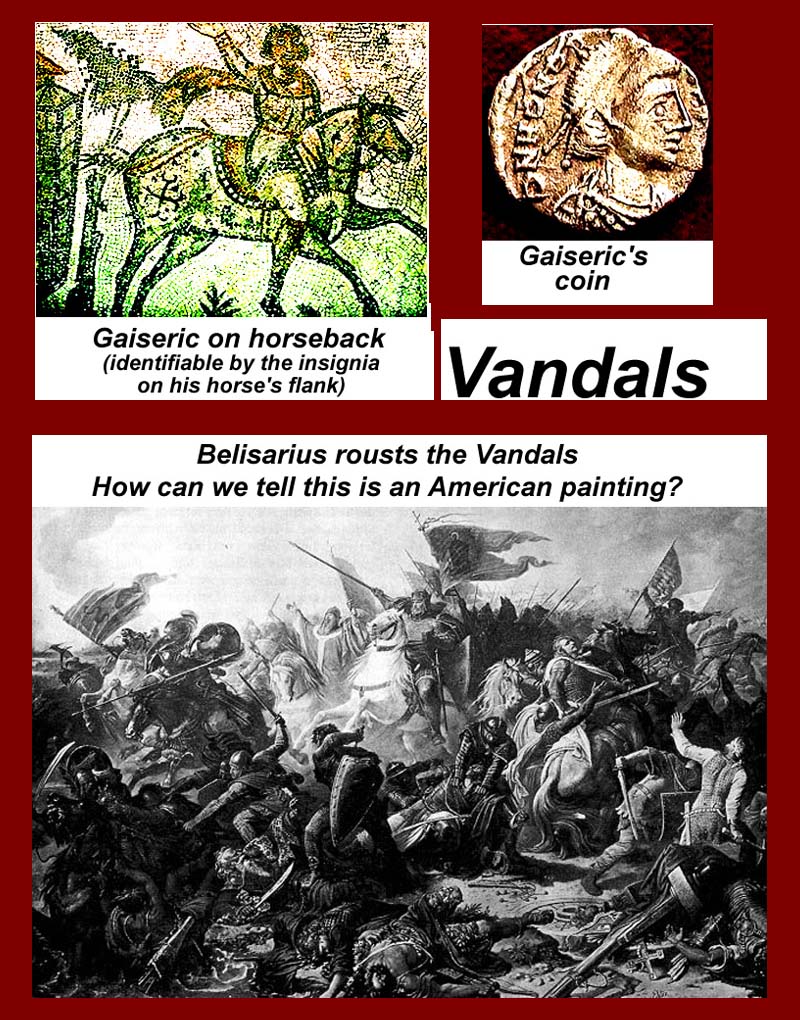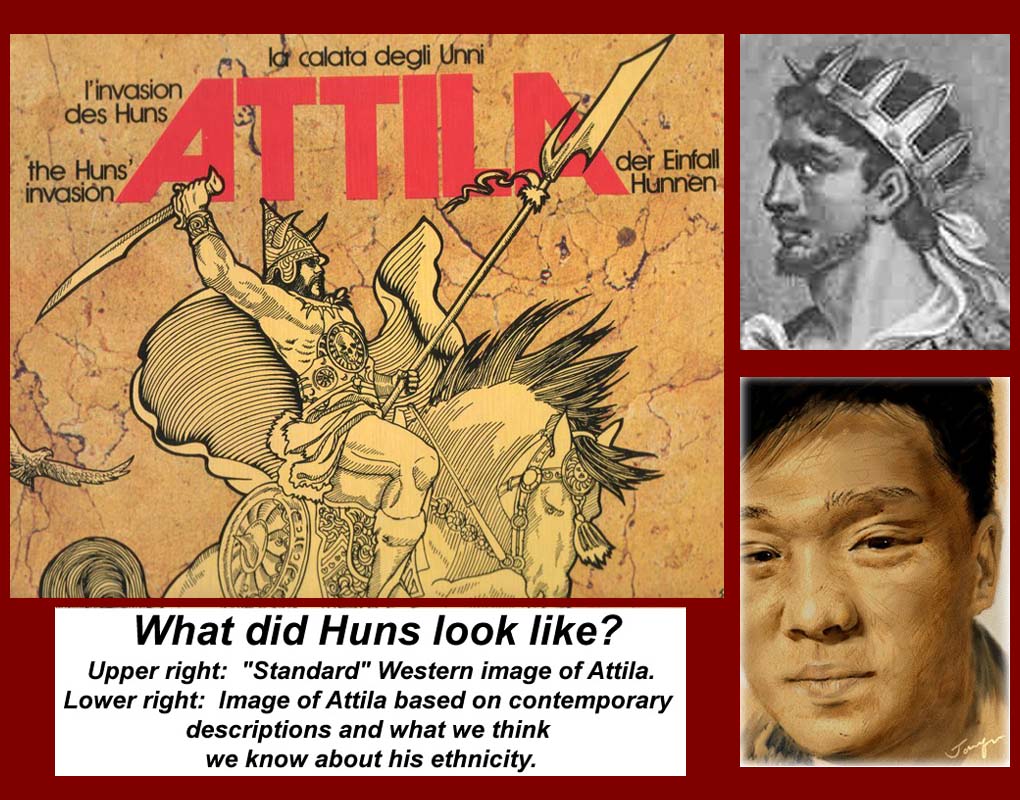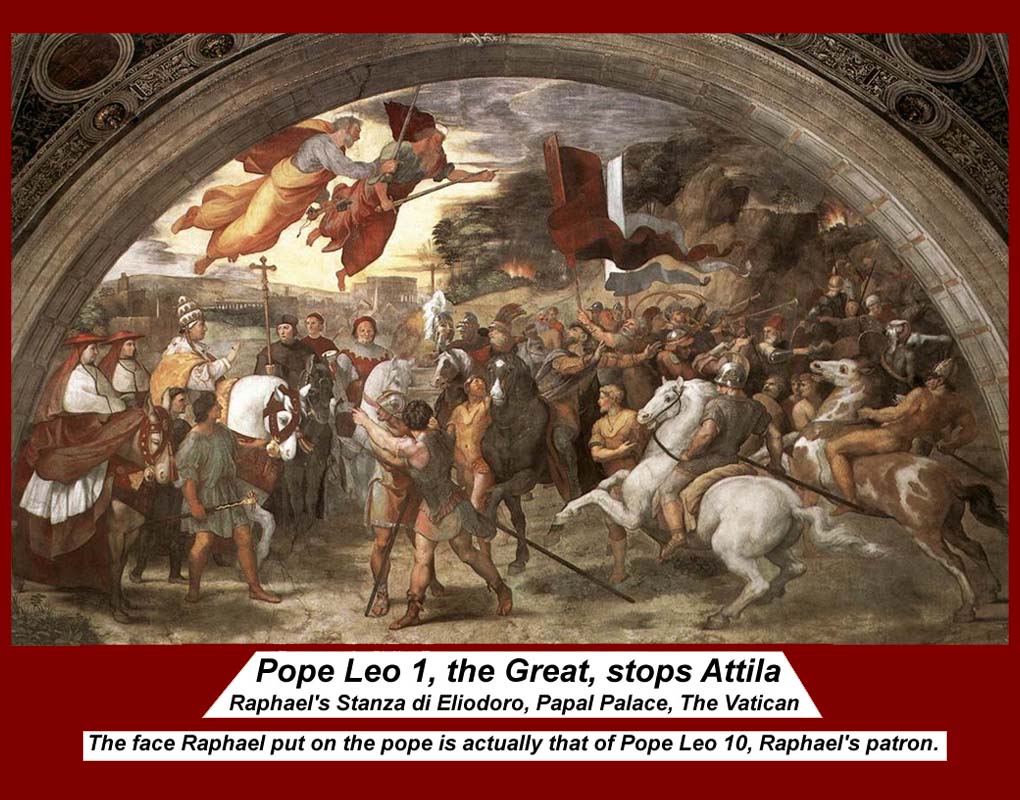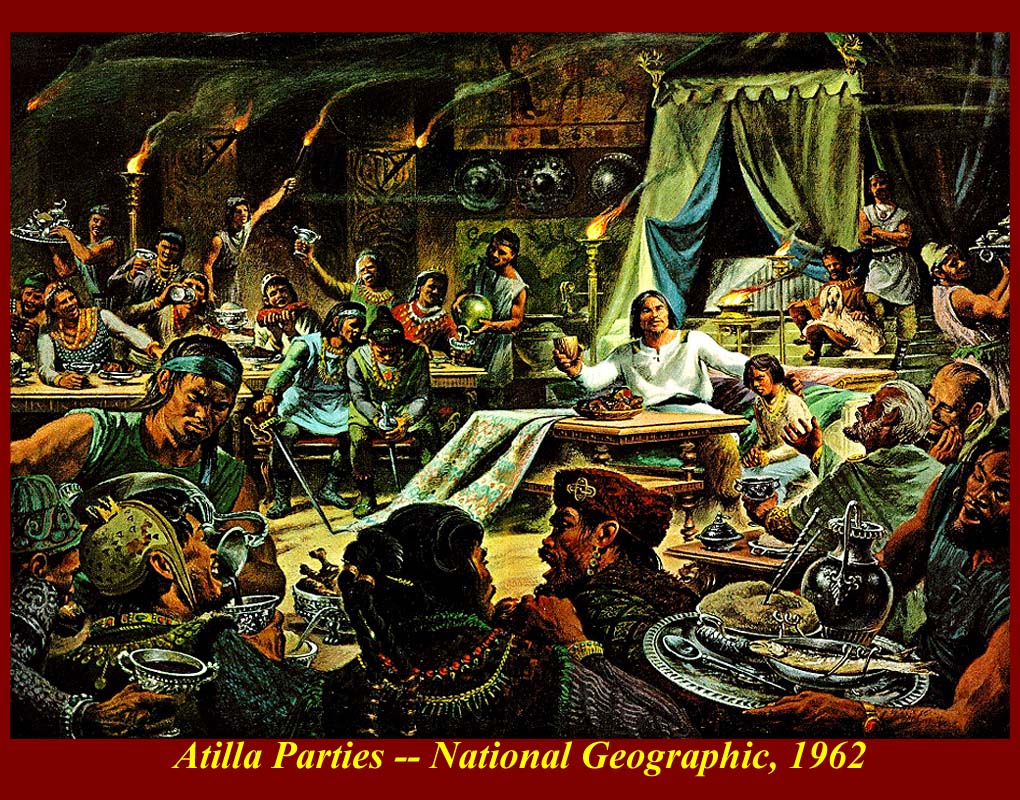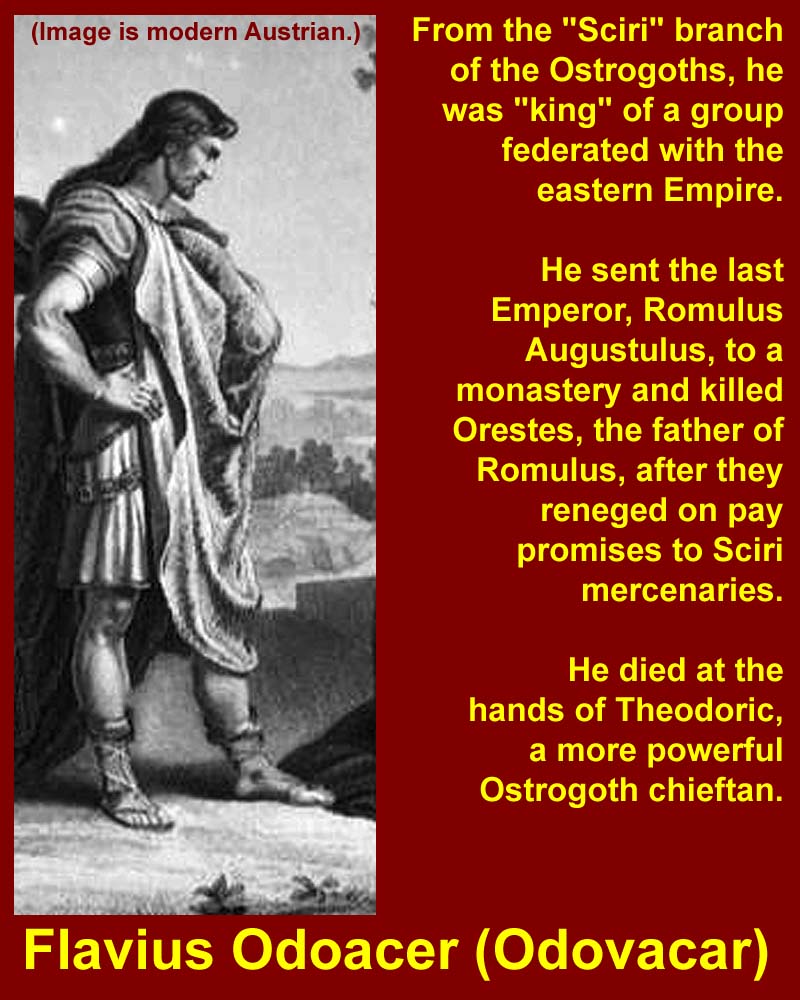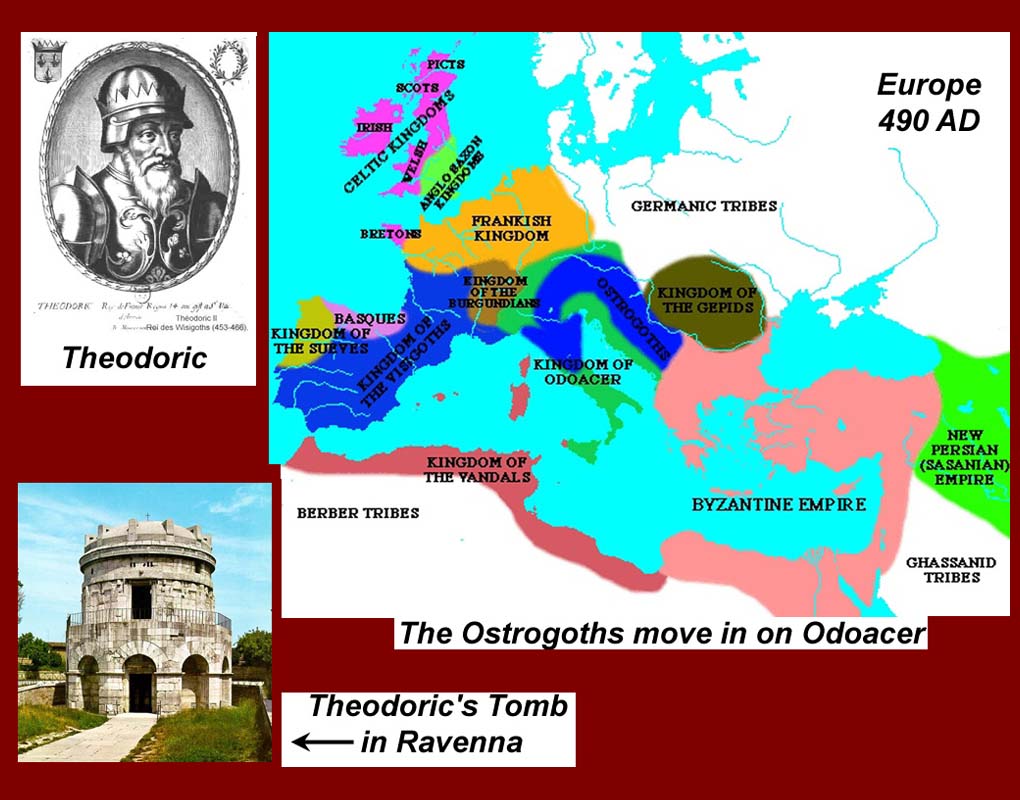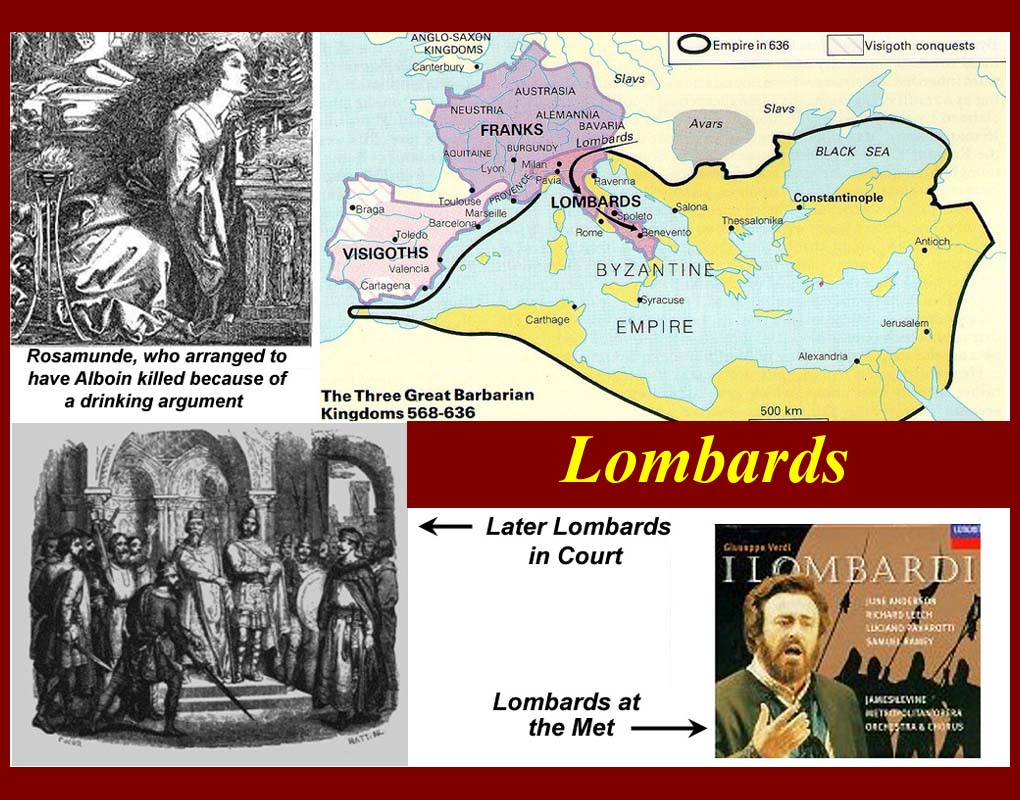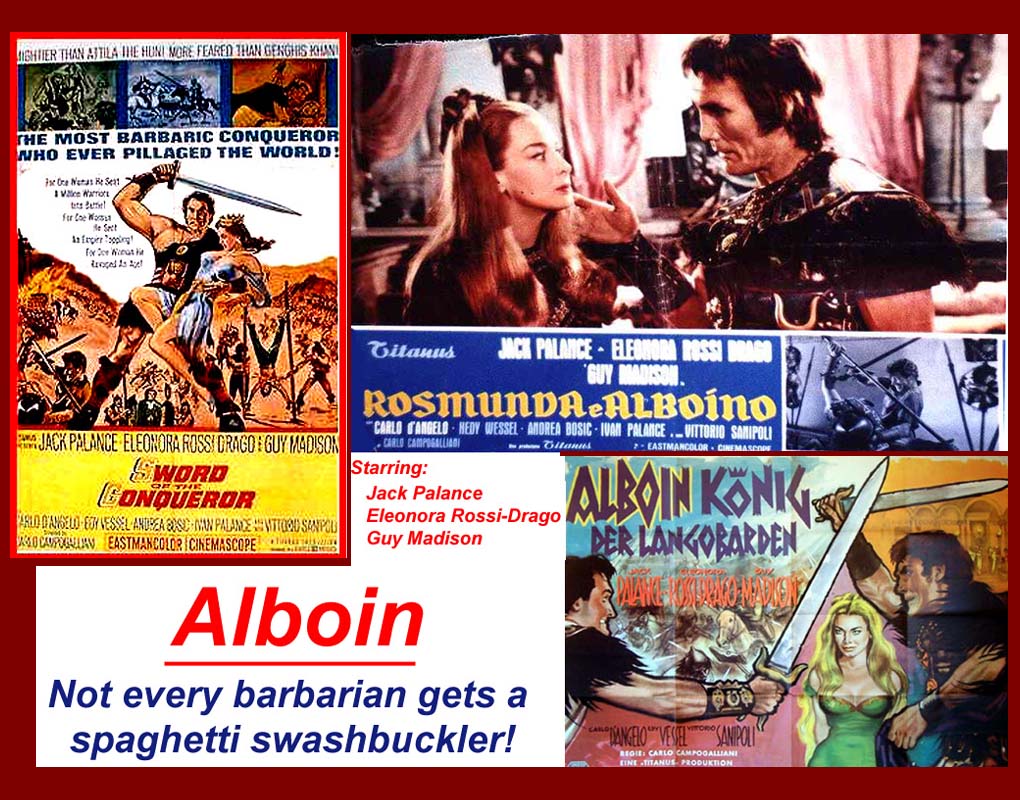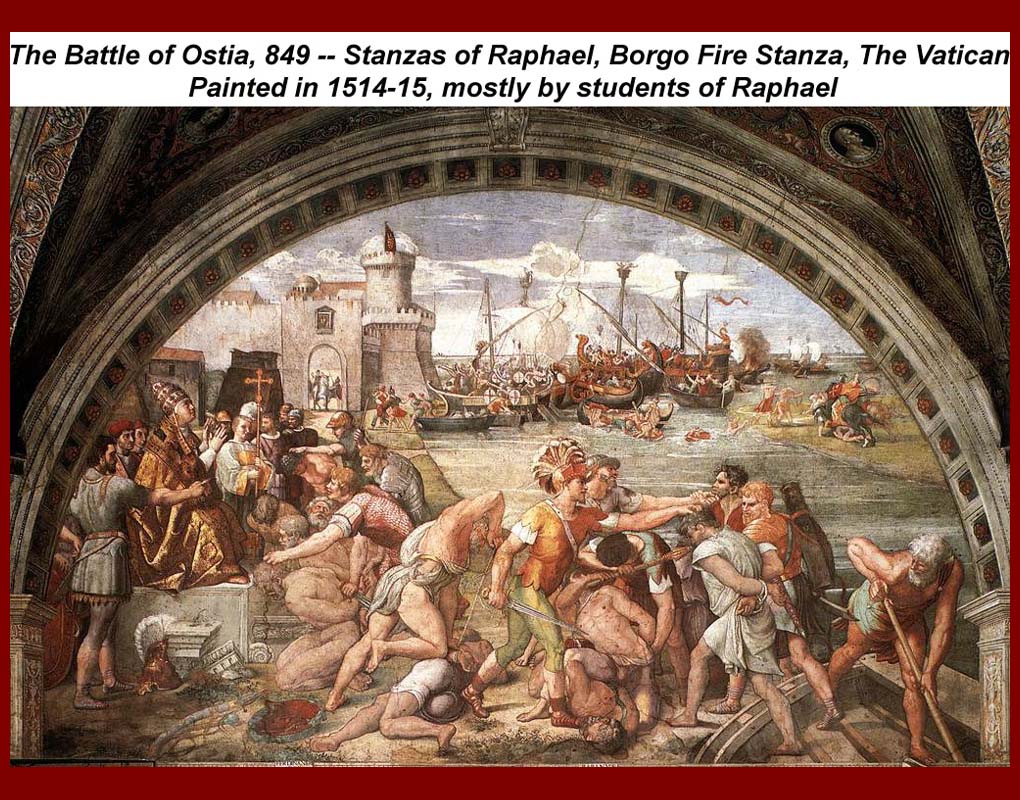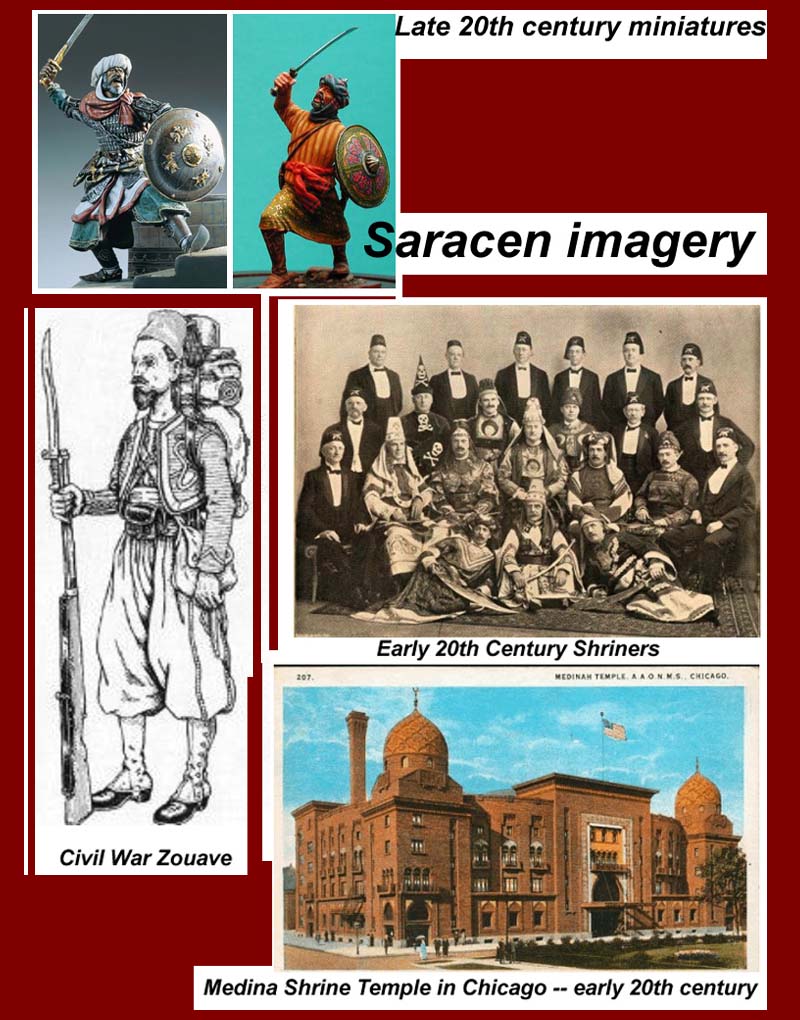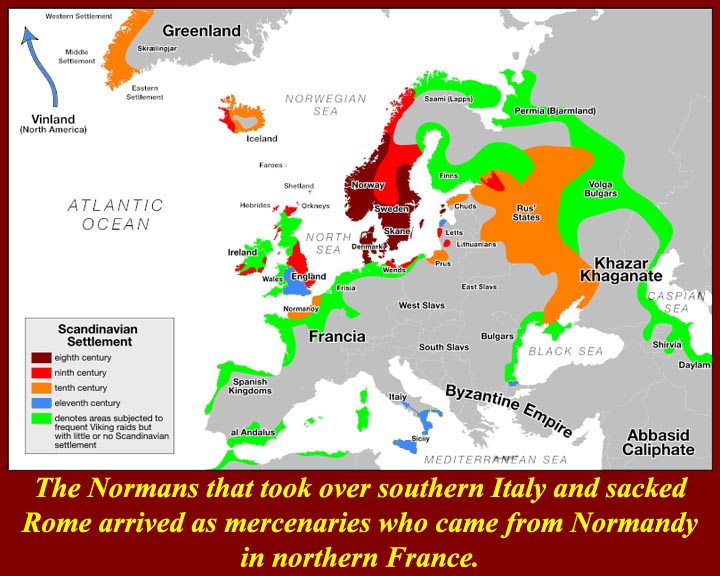Barbarians
It should be noted that the barbarians who sequentially attacked Roman territory were not nearly as barbaric as had been the ancient Romans, who were genocidal imperialists (e.g., Caesar claimed to have killed a million in Gaul) and who took their kids to their amphitheaters to inure them to bloodshed.
In the late medieval period, the Crusaders, organized and dispatched by the Church of Rome, were considered to be barbarians by the people of the Middle East. The Crusades, however, are a story for a different course.
We should note also that accounts from the Roman (i.e., the sacked) side of the stories of barbarian destruction tend to be lurid and overblown; buildings said to have been destroyed are still there, treasures lost are easily found in situ, etc. It's pretty much like the accounts of destruction and thievery in Baghdad during the recent war in Iraq or the supposed loss of the Timbuktu libraries. Many of the barbarian invaders of Roman territory were (Aryan) Christians, and that lessened the destruction of churches.
Click on small images or links below to go to larger images for Unit 2
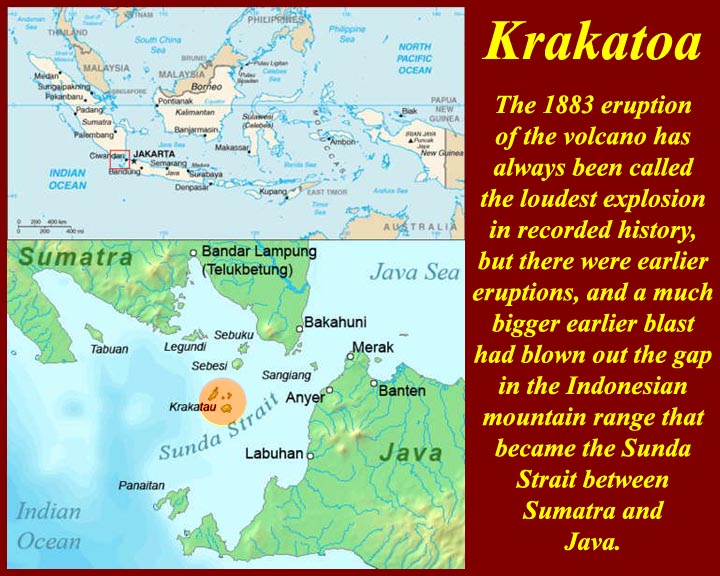
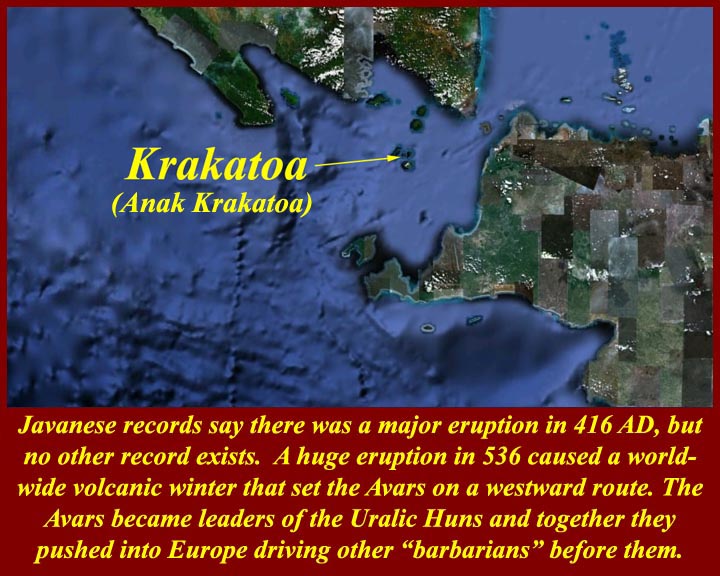
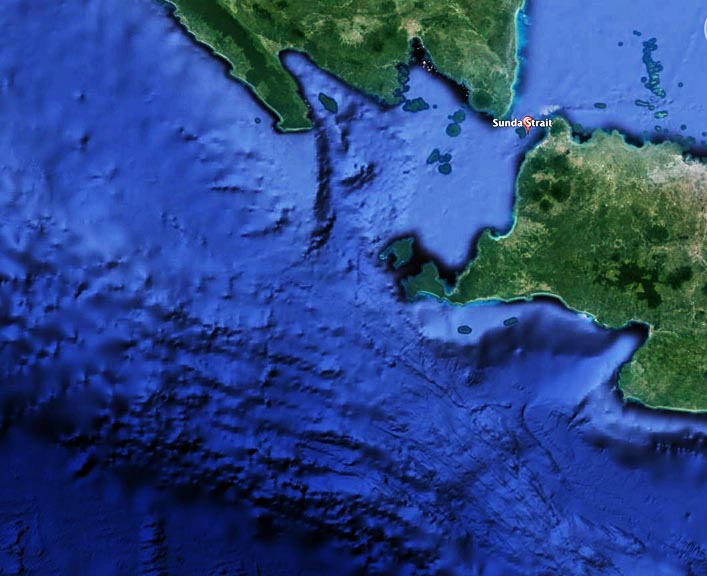
http://www.mmdtkw.org/MedRom0200aKrakatoaSundaStrait.jpg
http://www.mmdtkw.org/MedRom0200bKrakatoa535.jpg
http://www.mmdtkw.org/MedRom0200cAnakKrakatoa.jpg
A theory has been put forth that an eruption of Krakatoa in 536 AD caused a "volcanic winter" that led to the collapse of the Avars on China's western border -- they were the guys that China was trying to keep out with their Great Wall. Volcanic climate change caused the grasses of Central Asia to die off and that reduced the horse herd of these mounted warriors. The Avars started a long westward trek looking for (literally) greener pastures and ended up in the Urals where they linked up with other mounted warriors called Huns. The Avars took over the confederation and led the combined Hunnic/Avar forces into Europe pushing weaker (but still "dangerous") "barbarians before them.
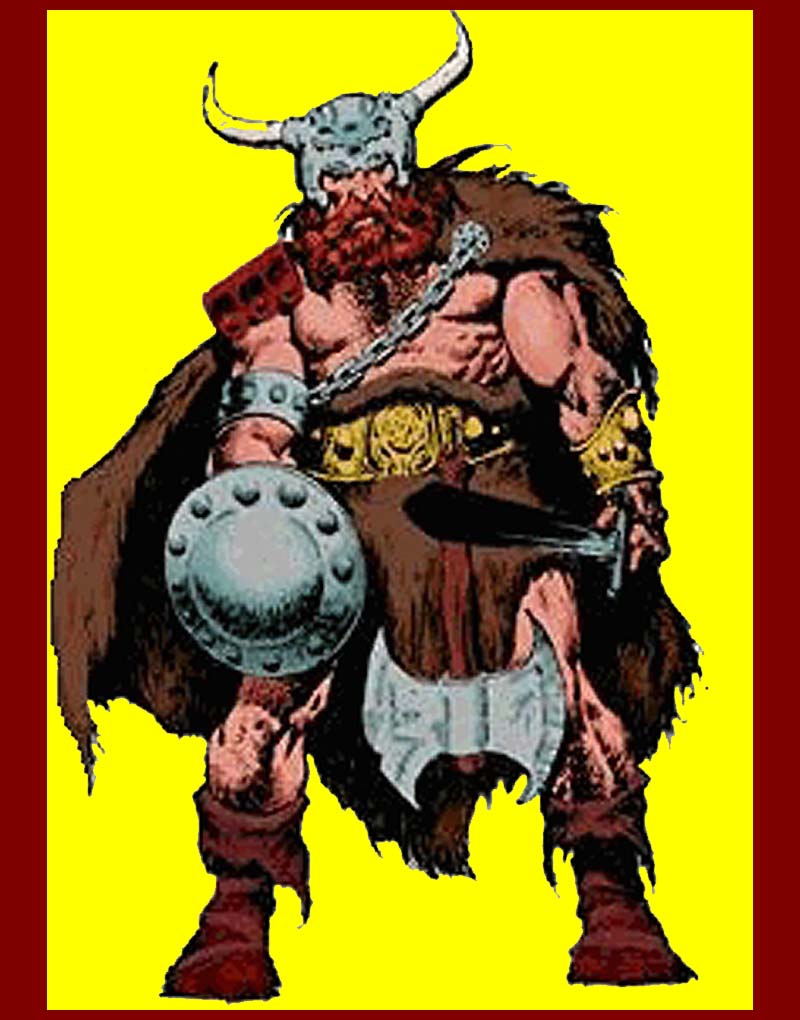
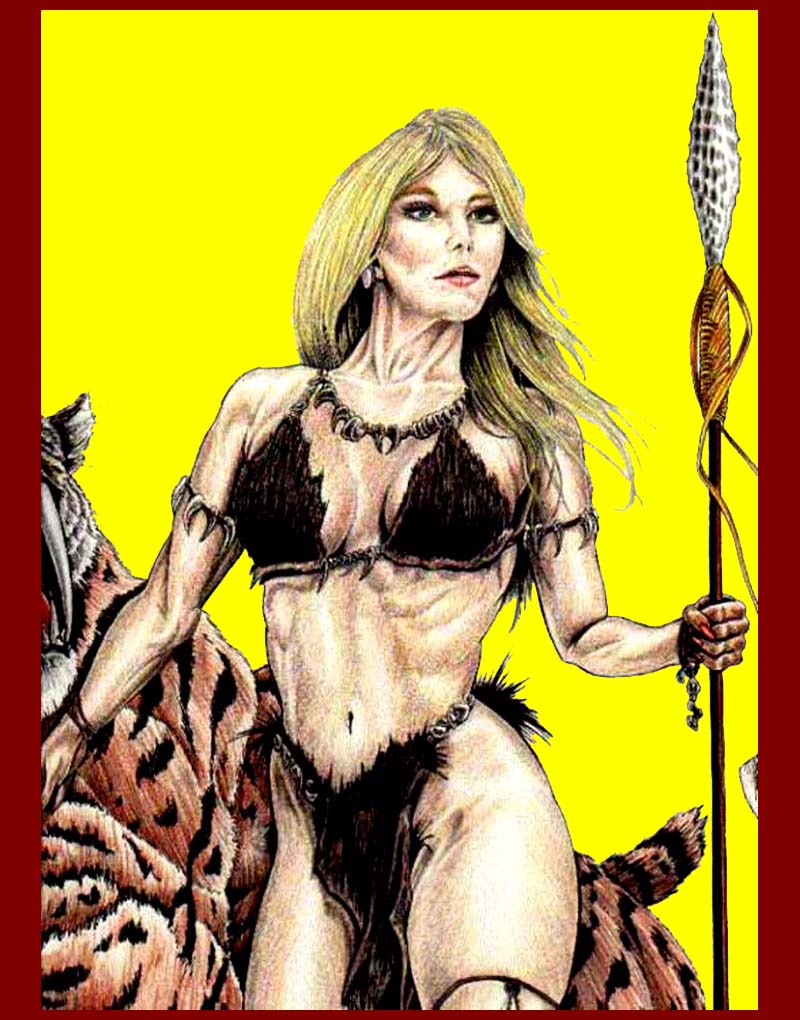

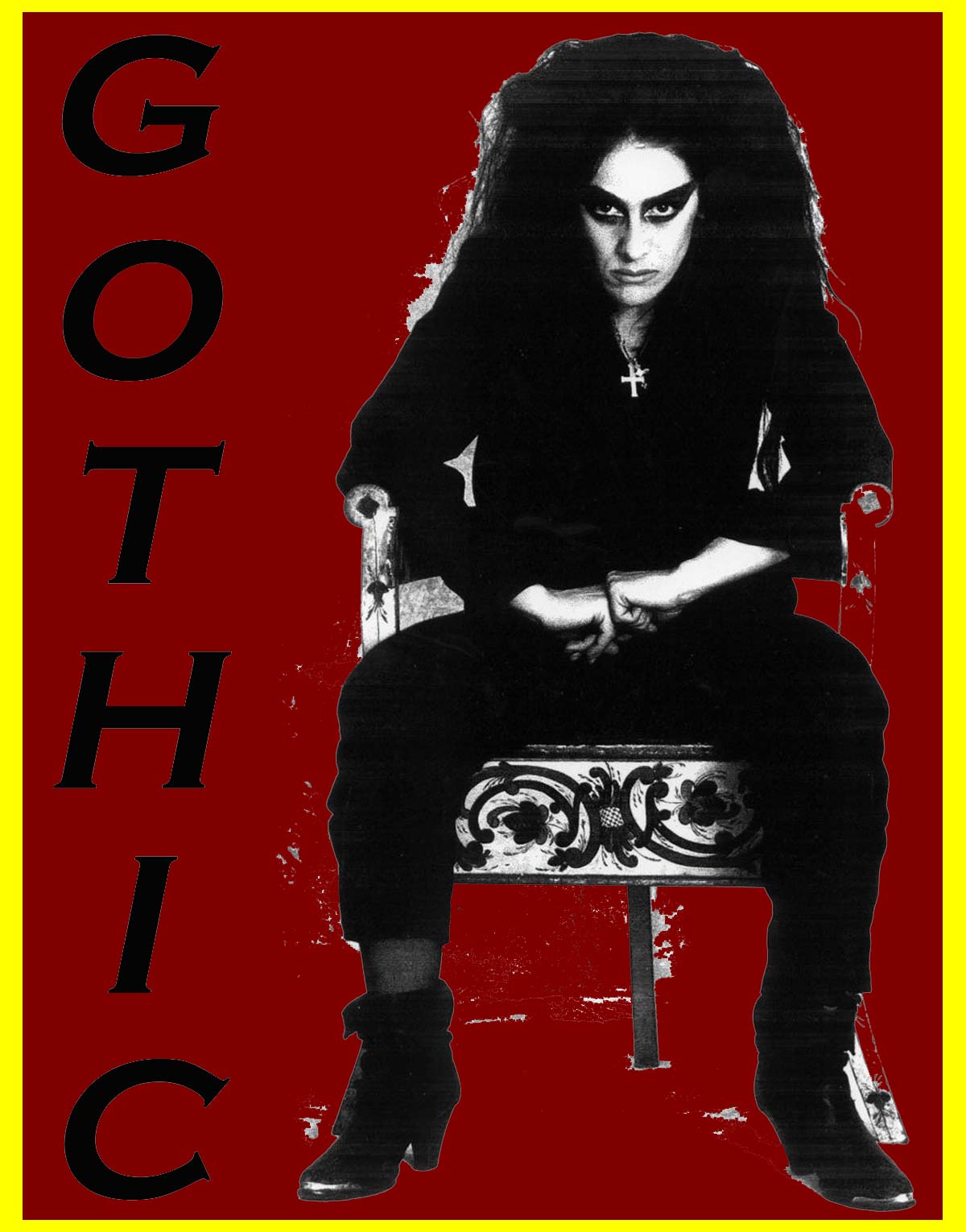
What Barbarians aren't -- Robust Barbarian -- Buxom Barbarian -- Terminator Barbarian -- Gothic Barbarian -- Gothic Barbarian
http://www.mmdtkw.org/MedRom0201RobustBarbarian.jpg
http://www.mmdtkw.org/MedRom0202FemBarbarian.jpg
http://www.mmdtkw.org/MedRom0203ArnoldBarbarian.jpg
http://www.mmdtkw.org/MedRom0204GothicBarbarian.jpg
http://www.mmdtkw.org/MedRom0205TooCleanBarbarian.jpg
http://www.mmdtkw.org/MedRom0206AlaricRomeNGeog.jpg
Alaric in Rome -- National Geographic 1962. The image, which we've seen before as a generic barbarian sack of Rome, is now revealed to be a guess at how Alaric's sack of Rome (410 AD) might have appeared.
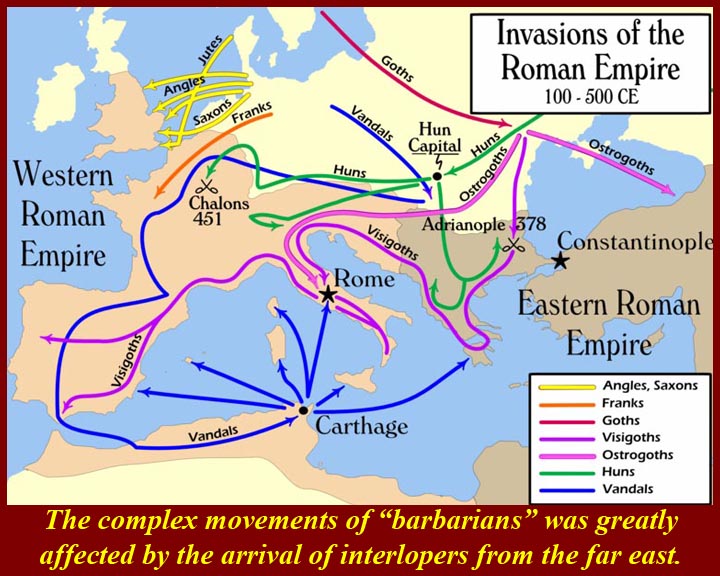
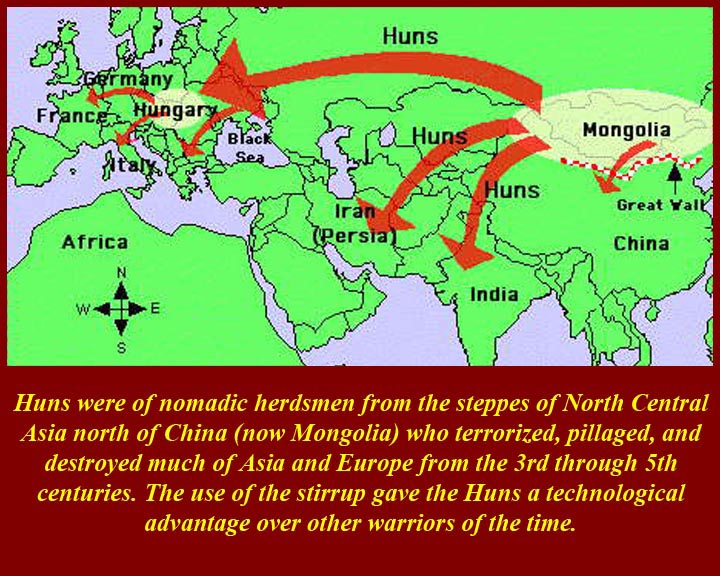
http://www.mmdtkw.org/MedRom0207aBarbariansInvade.jpg
http://www.mmdtkw.org/MedRom0207abHunsMap.jpg
http://www.mmdtkw.org/MedRom0207acVisigothInvasions_460x280.jpg
Maps of routes of barbarian migrations -- and they were almost always migrations. These groups moved a populations rather than as military forces. As noted above, the Huns pushed others before them. Some of these others had already begun to move southward when the Hus started to move then westward. On of the first waves to arrive at Rome were the Visigoths led by Alaric.
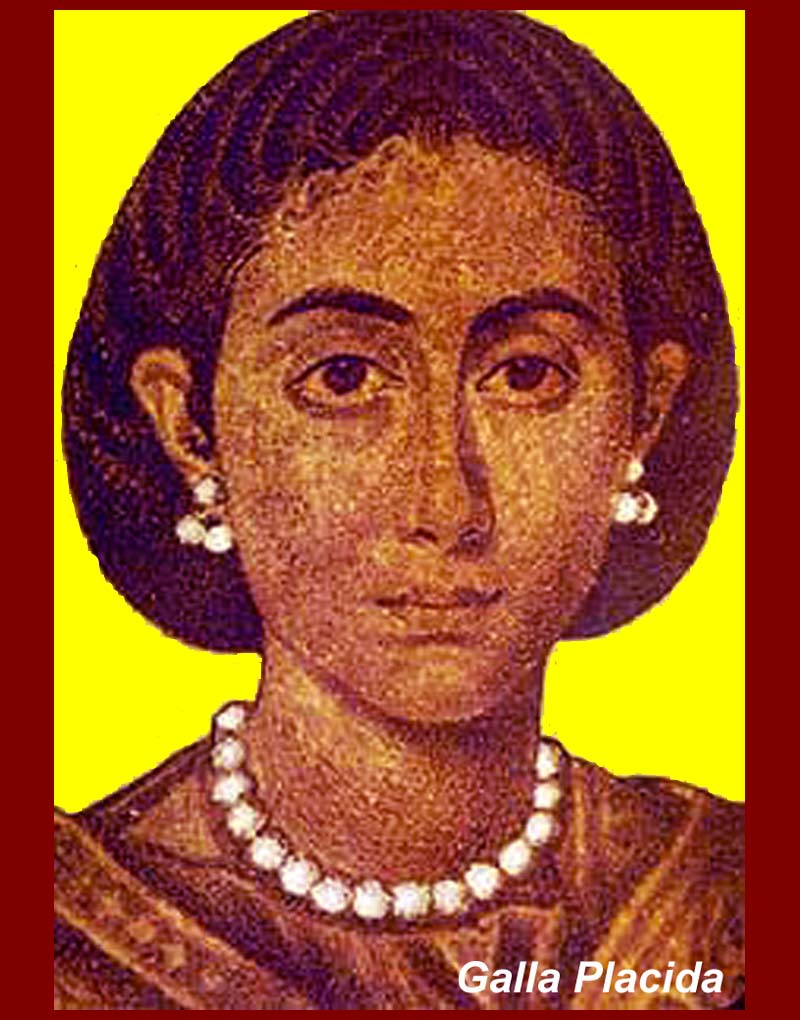
http://www.mmdtkw.org/MedRom0207GallaPlacida.jpg
http://www.mmdtkw.org/MedRom0208Stilicho.jpg
Galla Placida -- woman with connections. She was a daughter of Theodosius, a sister of Honorius, a hostage (lover? wife?) of Alaric, wife of Atawulf, wife of Constantius III, mother and regent of Valentinian III, sponsor of Aetius. See http://www.mmdtkw.org/VGallaPlacida.html.
Stilicho and Alaric -- for Alaric's sack of Rome in 410 and his troubled and troubling relationship with Stilicho, see http://www.mmdtkw.org/VAlaric.html.
http://www.mmdtkw.org/MedRom0209aVisigothKingdom.jpg
After the Visigoths withdrew from Italy under Atawulf, they settled in France. Eventually they were pushed into southwest France and into Spain. They were sometime allies of Rome and for a while absorbed the Vandals into their confederation. They joined with the Franks and Romans against the Huns at Chalons.
http://www.mmdtkw.org/MedRom0209Vandals.jpg
The general view is that the Vandals were eastern Germanic with, perhaps, an inter-mixture of Slavic groups. A minority view says they came into eastern Germany (Prussia) from some Nordic location. They were in eastern Germany when they first interacted with Rome in the 2nd century. They wended their way down through Germany, France, Spain, and then across to North Africa where they finally took Roman Carthage in 435 AD without a fight -- almost everyone was watching the chariot races and the Vandals just walked in. They then began to raid western Mediterranean shores as pirates and in 455 sacked Rome. In 534, having frown soft ans overly satisfied, the Vandal kingdom in North Africa fell to Belisarius. See http://en.wikipedia.org/wiki/Vandals for a more complete account of the Vandals.
Vandalism: "The Vandals, an ancient Germanic people, are associated with senseless destruction as a result of their sack of Rome under King Genseric in 455. During the Enlightenment, Rome was idealized, while the Goths and Vandals were blamed for its destruction. The Vandals may not have been any more destructive than other invaders of ancient times, but they did inspire British poet John Dryden to write, Till Goths, and Vandals, a rude Northern race, Did all the matchless Monuments deface (1694).
"The term Vandalisme was coined in 1794 by Henri Grégoire, bishop of Blois, to describe the destruction of artwork following the French Revolution. The term was quickly adopted across Europe. This new use of the term was important in colouring the perception of the Vandals from later Late Antiquity, popularising the pre-existing idea that they were a barbaric group with a taste for destruction."
http://www.mmdtkw.org/MedRom0210aAttilaTheHen.jpg
Attila the Hen
http://www.mmdtkw.org/MedRom0210AttilaFace.jpg
Attila's face -- what did he look like? Many representations of Attila show him as a European. From what we know about the history of the Huns and their Avar leadership, it's a good guess that he had Asian features.
http://www.mmdtkw.org/MedRom0211RaphaelAttila.jpg
After his defeat at Chalons, Attila led his forces down into Italy seeking a softer target. He terrorized northern Italy including the Venetto where some residents were said to have retreated to the mud banks that later became Venice. After marauding in the north Attila set his eye on Rome. Raphael's Attila in the Stanza di Eliodoro in the Vatican palace shows Sts. Peter and Paul flying over the scene of the meeting between Attila and Pope Leo I outside Rome. According to legend, this frightened off Attila. Most historians discount the miracle and say a bribe or the nearby presence of Aetius with an army did the trick -- or maybe Attila was superstitious and wanted to avoid the fate of Alaric, who died shortly after sacking Rome. Leo I got credit for the miracle, but Raphael was clever enough to paint in the features of his sponsor Leo X (Medici) on the image of the Pope. (Raphael also painted himself, beside he Pope's horse.)
See http://www.fordham.edu/halsall/source/attila2.html.
http://www.mmdtkw.org/MedRom0212AtillaParties.jpg
Attila celebrates -- National Geographic 1962. It was perhaps at a party like this that Attila got the injury that killed him. After the Huns retreated from Italy, Attila, the story goes, had arranged yet another alliance by an arranged marriage with the daughter of a tribal chief -- one of several such marriages. At the wedding feast, the story goes, he and a henchman/best man indulged in a ritualized wrestling match for the favor of the bride. Attila naturally won, but, the story goes, got a nosebleed. Later that night, he died in the bed of his new bride when the nosebleed recurred -- drowned in his own blood (the story goes). Other versions have the bride stabbing him to death, because he used her father's skull as a goblet at the wedding feast. In Verdi's opera Attila, his proposed Italian bride slays him with her father's sword. Attila had taken over the leadership of the Huns in 434 and died in 453.
Whatever the cause, his death was the signal for the dissolution of the Hunnic confederation of tribes. An Ostrogoth led away his compatriots, and a Roman/barbarian half-breed led off much of the cavalry. The half breed was Orestes, who led his cavalry to Ravenna where he offered his services to Western Emperor Julius Nepos. Julius had no choice but to accept -- and he was soon sent packing and Orestes' young son, Romulus Augustus (aka Augustulus) was set upon the imperial throne. Romulus Augustulus was the last Emperor of the West and is sometimes called the "Last Roman Emperor". Odoacer, leading dissident troops, soon dispatched Orestes, who had styled himself Patrician, and he sent teen-aged Romulous packing. Romulus and his mother started a monastery where they lived out their time in obscurity. Romulus Augustulus "ruled", under the thumb of his father, from 31 October 475 until 4 September 476. His deposition by Odoacer traditionally marks the end of the Western Roman Empire, the fall of ancient Rome, and the beginning of the Middle Ages in Western Europe.
See http://schools-wikipedia.org/wp/r/Romulus_Augustulus.htm,
http://www.roman-emperors.org/auggiero.htm, and
http://en.wikipedia.org/wiki/Orestes_(father_of_Romulus_Augustulus)
http://www.mmdtkw.org/MedRom0212aOdoacer.jpg
Odoacer, leading dissident troops, soon dispatched Orestes, who had styled himself Patrician, and he sent teen-aged Romulous packing. Next to arrive was Theodoric. See http://en.wikipedia.org/wiki/Odoacer
http://www.mmdtkw.org/MedRom0213Ostrogoths.jpg
Ostrogoths. The Ostrogothic Kingdom established by the Ostrogoths in Italy and neighbouring areas lasted from 493 to 553. In Italy the Ostrogoths replaced Odoacer, the de facto ruler of Italy who had deposed the last emperor of the Western Roman Empire in 476. The Gothic kingdom reached its zenith under the rule of its first king, Theodoric the Great. Most of the social institutions in the late Western Roman Empire were preserved during his rule.
Starting in 535, the Eastern Roman Empire invaded Italy. The Ostrogothic ruler at that time, Witiges, could not defend successfully and was finally captured when the capital Ravenna fell. The Ostrogoths rallied around a new leader, Totila, and largely managed to reverse the conquest, but were eventually defeated. The last king of the Ostrogothic Kingdom was Teia.Flavius Theodericus, also known as Theodoric the Great (Gothic: Şiudareiks; Latin: Flāvius Theodericus; Greek: Θευδέριχος, (Theυ'ğerichos, /θɛuˈğɛrixos/); Old English: Şēodrīc; German: Theoderich der Große; Old Norse: Şjóğrekr, Şiğrek), 454 30 August 526, was king of the Ostrogoths (471 526), ruler of Italy (493 526), regent of the Visigoths (511 526), and a viceroy of the Eastern Roman Empire. His Gothic name "Şiuda reiks" translates into "people's king". He became a hero of Germanic legend.
See http://en.wikipedia.org/wiki/Ostrogothic_Kingdom and
http://www.newadvent.org/cathen/14576a.htm and
http://en.wikipedia.org/wiki/Theodoric_the_Great
http://www.mmdtkw.org/MedRom0215Lombards.jpg
Lombards in northern Italy. Alboin (530s June 28, 572) was king of the Lombards from about 560 until 572. During his reign the Lombards ended their migrations by settling in Italy, the northern part of which Alboin conquered between 569 and 572. He had a lasting impact on Italy and the Pannonian Basin; in the former his invasion marked the beginning of centuries of Lombard rule, and in the latter his defeat of the Gepids and his departure from Pannonia ended the dominance of the Germanic peoples.
After succeeding in gathering together a large coalition of peoples, Alboin began his trek in 568. After crossing the Julian Alps he entered an almost undefended Italy, and rapidly took control of most of Venetia and Liguria. In 569, unopposed, he took northern Italy's main city, Milan. Pavia offered stiff resistance however, and was only taken after a siege lasting three years. During that time Alboin turned his attention to Tuscany, but signs of factionalism among his supporters and Alboin's diminishing control over his army increasingly began to manifest themselves.
Alboin was assassinated on June 28, 572, in a coup d'état instigated by the Byzantines. It was organized by the king's foster brother, Helmegis, with the support of Alboin's wife, Rosamund, daughter of the Gepid king whom Alboin had killed some years earlier. The coup failed in the face of opposition from a majority of the Lombards, who elected Cleph as Alboin's successor, forcing Helmegis and Rosamund to flee to Ravenna under imperial protection. Alboin's death deprived the Lombards of the only leader who could have kept the newborn Germanic entity together, the last in the line of hero-kings who had led the Lombards through their migrations from Elba to Italy. For many centuries following his death Alboin's heroism and his success in battle were celebrated in Saxon and Bavarian epic poetry.
Rosamunda was said to have resented the fact that Alboin used her father's skull for a wine goblet. If the story sounds familiar, it's because the same story was sometimes told about Attila's wife and his murder by her.
See http://en.wikipedia.org/wiki/Alboin
http://www.mmdtkw.org/MedRom0214AlboinMovie.jpg
Alboin's spaghetti western -- although not the only barbarian to get a Verdi opera, Alboin was the only one who got a the spaghetti treatment, with Jack Palance no less.
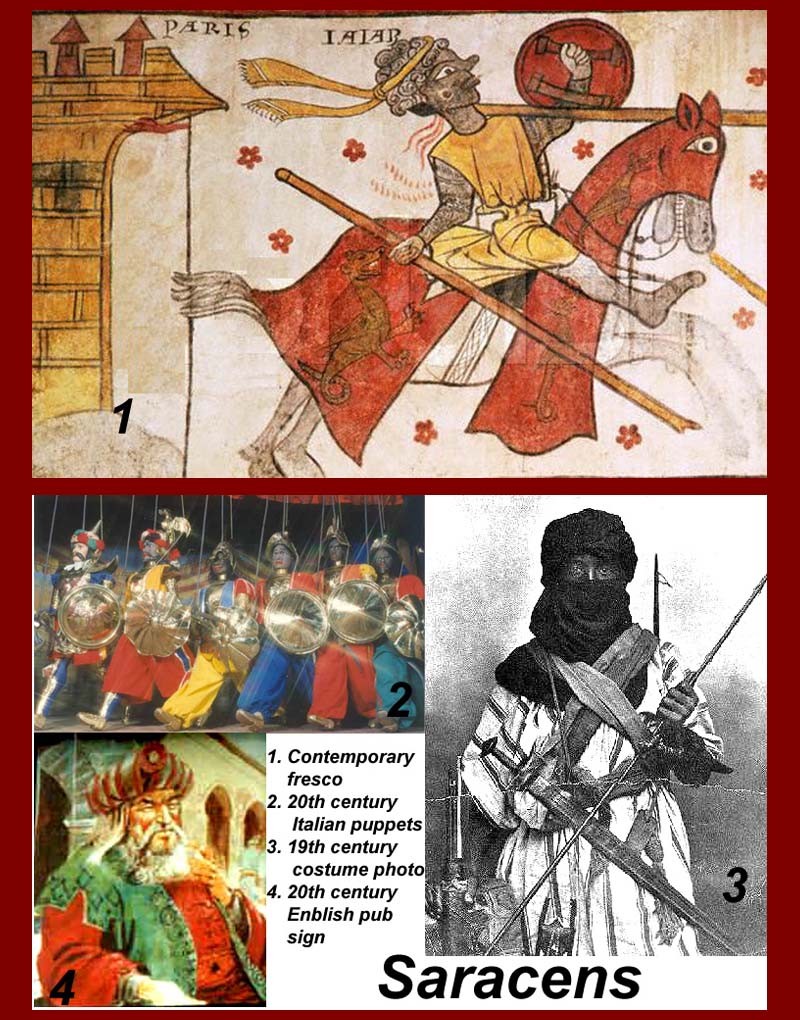
http://www.mmdtkw.org/MedRom0216Saracens.jpg
http://www.mmdtkw.org/MedRom0217OstiaBattle.jpg
Saracens were what the Italians called the Muslim pirates who attacked coastal cities. During the 8th and 9th centuries, Muslim Arabs had begun to expand aggressively into Southern Italy. These newcomers, sailing from their bases in North Africa, had conquered Sicily and had begun a steady attack of the peninsula.
The Raphael painting shows the Saracens defeated at Ostia (Raphael Stanze, Vatican). This heroic image was, of course, after they had already sacked the Vatican and St. Paul's outside the walls in 846. The losses in gold at the Vatican were particularly large, because the pope had gathered the treasures of the Roman churches there, supposedly for safekeeping. In the aftermath of the sacks, both the Vatican and St. Paul's were fortified. See http://en.wikipedia.org/wiki/Leonine_City.
http://www.mmdtkw.org/MedRom0218SaracenImagery.jpg
Saracen imagery in the West -- the romance of the exotic. Western military and fraternal organizations adopted the look of the Saracens.
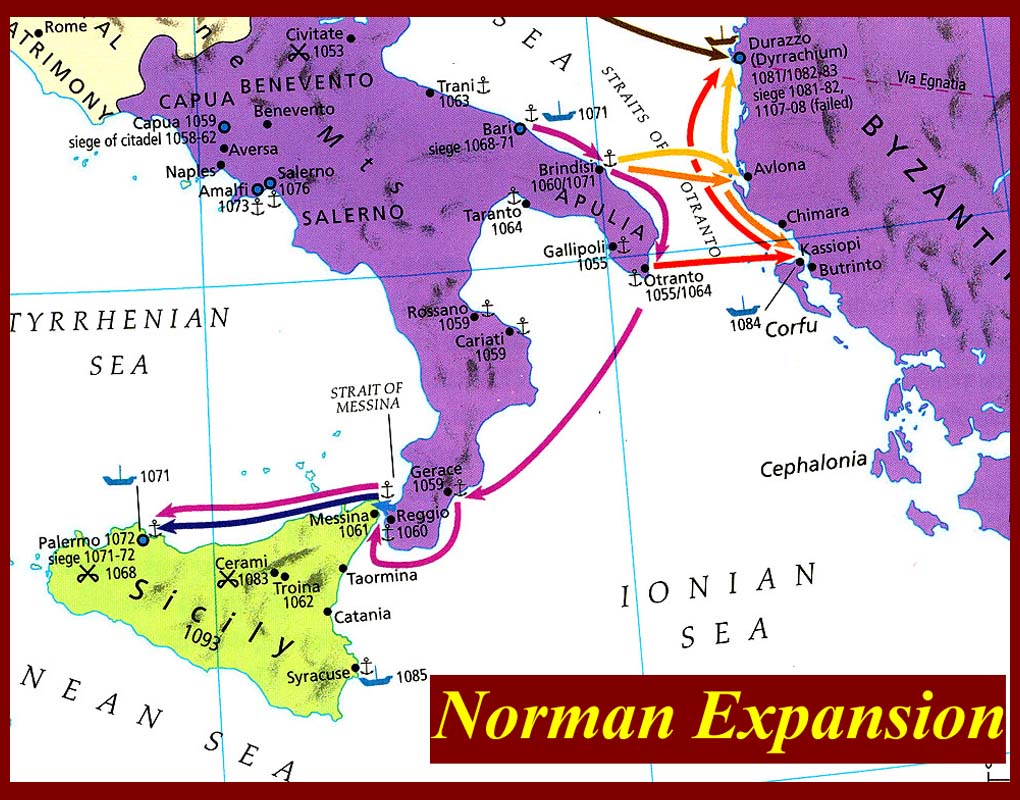
http://www.mmdtkw.org/MedRom0219xNormanOrigins copy.jpg
http://www.mmdtkw.org/MedRom0219NormanExpansion.JPG
Normans -- Expansion
The Sack of Rome of May 1084 was a Norman sack, the result of the pope's call for aid from the duke of Apulia, Robert Guiscard.
Pope Gregory VII was besieged in the Castel Sant'Angelo by the Emperor Henry IV in June 1083. He held out and called for aid from the Guiscard, who was then fighting the Byzantine Emperor Alexius I Comnenus in the Balkans. Guiscard returned to Italy and marched north with 36,000 men. He entered Rome and forced Henry to retire, but a riot of the citizens led to a three days' sack, after which Guiscard escorted the pope to the Lateran. The Normans had mainly pillaged the old city, which was then one of the richest cities in Italy.
After days of violence, the Romans rose up causing the Normans to set fire to the city. Many of the buildings of Rome were gutted on the Capitol and Palatine hills along with the area between the Colosseum and the Lateran (see http://www.mmdtkw.org/MedRom0137-QuatCoronExpan.jpg). In the end the Roman populace succumbed to the Normans.
See http://en.wikipedia.org/wiki/Robert_Guiscard and
http://www.newadvent.org/cathen/07072b.htm (Robert Guiscard)
http://www.mmdtkw.org/MedRom0220NormanArchitecture.jpg
The term Norman architecture is used to categorize styles of Romanesque architecture developed by the Normans in the various lands under their dominion or influence in the 11th and 12th centuries. In particular the term is traditionally used for English Romanesque architecture. The Normans introduced large numbers of castles and fortifications including Norman keeps, and at the same time monasteries, abbeys, churches and cathedrals, in a style characterized by the usual Romanesque rounded arches (particularly over windows and doorways) and especially massive proportions compared to other regional variations of the style. In England, all Romanesque architecture is called Norman. It is generally accepted that Gothic architecture developed from Norman Romanesque architecture.
Our own example, which is probably seen by more people than any other, is the Smithsonian Castle on the Mall in Washington DC.

